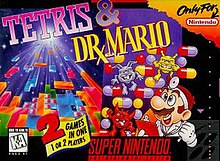Tetris & Dr. Mario
| Tetris & Dr. Mario | |
|---|---|
 | |
| Developer(s) | Intelligent Systems |
| Publisher(s) | Nintendo |
| Composer(s) | Kazumi Totaka |
| Series | Dr. Mario Tetris |
| Platform(s) | SNES |
| Release | |
| Genre(s) | Puzzle |
| Mode(s) | Single player, multiplayer |
Tetris & Dr. Mario is a 1994 puzzle video game compilation developed by Intelligent Systems and published by Nintendo for the Super Nintendo Entertainment System. It contains enhanced remakes of Tetris (1984) and Dr. Mario (1990), which were originally released for both the Nintendo Entertainment System and Game Boy in North America. Both games include split-screen multiplayer and a "Mixed Match" mode that transitions between the two games.
Development was by Intelligent Systems, and was one of the last SNES games released in North America. The Japanese version of the game excludes Tetris due to Bullet-Proof Software holding the rights to the series in Japan. The remake of Dr. Mario was also broadcast through the Satellaview, renamed BS Dr. Mario, and was the last game to be broadcast on the system. Tetris & Dr. Mario received generally positive reviews, with critics praising its controls and multiplayer, particularly the Mixed Match mode.
Gameplay

Tetris & Dr. Mario shares a similar design to the respective NES versions of the games included while featuring music from their Game Boy versions. In Tetris, the player must use different types of falling tetrominoes to form complete lines from the left to the right of the playfield, without any holes between them.[1] Completed lines will disappear and cause any blocks on top to fall towards the bottom.[1] The player can rotate the blocks to place them in specific spots, and can also hold down to make them fall faster.[1] Once all the blocks reach the top of the screen, the game will be over. Tetris includes the "A-Type" and "B-Type" modes from the Game Boy version, alongside a head-to-head multiplayer mode.[1]
In Dr. Mario, the player must use colored pills to defeat the viruses littered around the playfield. Viruses come in red, yellow and blue, and must be eliminated by matching two or more same-colored pills either horizontally or vertically.[1] Pills can be rotated around, and can be dropped faster by pressing down.[1] Once all the viruses have been cleared, the player will move onto the next stage.[1] The game will be over if all the pills reach the top of the screen.[1] Dr. Mario features a two-player mode where both players must compete against each other to clear the stage of viruses.[1]
Alongside both games, a "Mixed Match" multiplayer mode is also included, where players must compete for the most points before the time runs out.[1] The mode transitions between both games as players progress, beginning at Tetris' B-Type mode before moving to Dr. Mario and so forth.[1] The person with the most points at the end is deemed the winner.[1] Before the game begins, the player can customize the game's music, time limit and difficulty level.[1]
Development
Tetris & Dr. Mario was developed by Intelligent Systems. It was released exclusively in North America and was one of the last Super Nintendo games released.[2] The Japanese version contains only Dr. Mario, as Bullet-Proof Software held the Tetris license in Japan. The updated version of Dr. Mario used in this game was also used in BS Dr. Mario for the Satellaview. Composer Kazumi Totaka contributed music to the game.[3]
Reception
Since its release, Tetris & Dr. Mario received generally positive reception. It ranked 27th on IGN's top list of Super Nintendo games, which noted that the Mixed Match mode was a big part of why it was so good.[5] Tetris & Dr. Mario was particularly successful for its multiplayer component.[6] Writer Fran Mirabella called it a "puzzle lover's dream cartridge."[7] TechRadar's Gerald Lynch noted its absence on the SNES Classic, arguing that it should be included for its Tetris mode.[8] It sold 6 million copies, which a Kombo writer attributed to its Mixed Match mode.[9] Writer Andromeda praised the Mixed Match mode and the game's controls, stating that they are "better as a pair than they were alone."[4] Author Andy Slaven praised the NES versions of the included games and compared the compilation to Super Mario All-Stars.[10]
References
- ^ a b c d e f g h i j k l m Tetris & Dr. Mario (PDF). Nintendo. 30 December 1994. Retrieved 17 August 2019.
- ^ "Unsung Heroes: Intelligent Systems". GameZone. May 4, 2012. Retrieved June 8, 2019.
- ^ "Kazumi Totaka". Video Game Music Online. Retrieved June 8, 2019.
- ^ a b Andromeda (April 1995). "Super NES - Tetris & Dr. Mario". No. 69. GamePro. p. 86. Retrieved 17 August 2019.
- ^ "Top 100 SNES Games of All Time". IGN. Retrieved June 8, 2019.
- ^ Davis, Noah (June 12, 2012). "Tetris: can a Cold War classic evolve for the touchscreen?". The Verge. Retrieved June 8, 2019.
- ^ Mirabella, Fran (April 17, 2001). "Dr. Mario 64". IGN. Retrieved June 8, 2019.
- ^ Lynch, Gerald (June 27, 2017). "10 classic games the SNES Mini is missing". TechRadar. Retrieved June 8, 2019.
- ^ "The Slow Decline of the Virtual Console". Engadget. May 4, 2012. Retrieved June 8, 2019.
- ^ Slaven, Andy (2002). Video Game Bible, 1985-2002. Trafford Publishing. p. 172. ISBN 1553697316.

